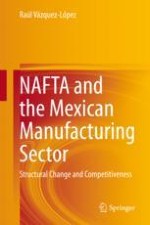2020 | OriginalPaper | Chapter
4. The Transformation of the Textile and Apparel Sector After NAFTA
Author : Raúl Vázquez-López
Published in: NAFTA and the Mexican Manufacturing Sector
Publisher: Springer International Publishing
Activate our intelligent search to find suitable subject content or patents.
Select sections of text to find matching patents with Artificial Intelligence. powered by
Select sections of text to find additional relevant content using AI-assisted search. powered by
